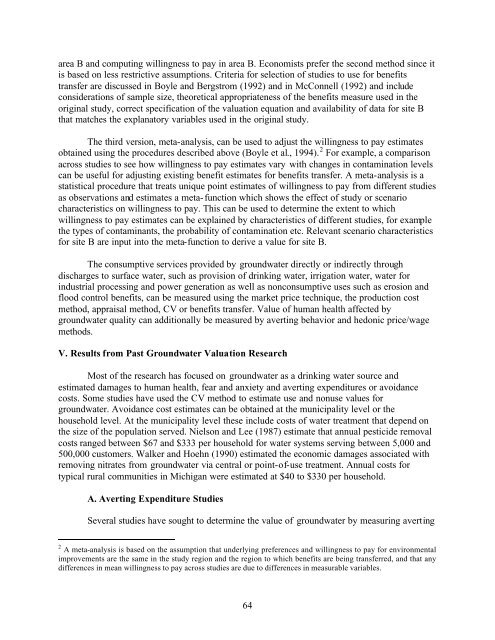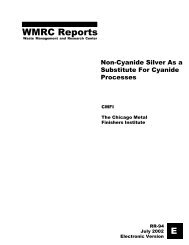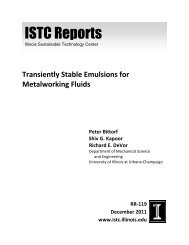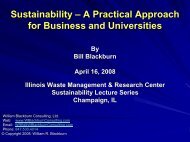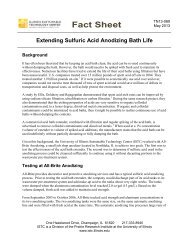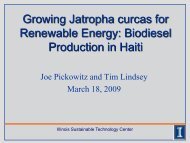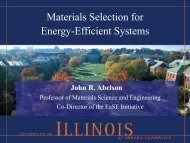Natural Resource Damage Assessment: Methods and Cases
Natural Resource Damage Assessment: Methods and Cases
Natural Resource Damage Assessment: Methods and Cases
You also want an ePaper? Increase the reach of your titles
YUMPU automatically turns print PDFs into web optimized ePapers that Google loves.
area B <strong>and</strong> computing willingness to pay in area B. Economists prefer the second method since it<br />
is based on less restrictive assumptions. Criteria for selection of studies to use for benefits<br />
transfer are discussed in Boyle <strong>and</strong> Bergstrom (1992) <strong>and</strong> in McConnell (1992) <strong>and</strong> include<br />
considerations of sample size, theoretical appropriateness of the benefits measure used in the<br />
original study, correct specification of the valuation equation <strong>and</strong> availability of data for site B<br />
that matches the explanatory variables used in the original study.<br />
The third version, meta-analysis, can be used to adjust the willingness to pay estimates<br />
obtained using the procedures described above (Boyle et al., 1994). 2 For example, a comparison<br />
across studies to see how willingness to pay estimates vary with changes in contamination levels<br />
can be useful for adjusting existing benefit estimates for benefits transfer. A meta-analysis is a<br />
statistical procedure that treats unique point estimates of willingness to pay from different studies<br />
as observations <strong>and</strong> estimates a meta-function which shows the effect of study or scenario<br />
characteristics on willingness to pay. This can be used to determine the extent to which<br />
willingness to pay estimates can be explained by characteristics of different studies, for example<br />
the types of contaminants, the probability of contamination etc. Relevant scenario characteristics<br />
for site B are input into the meta-function to derive a value for site B.<br />
The consumptive services provided by groundwater directly or indirectly through<br />
discharges to surface water, such as provision of drinking water, irrigation water, water for<br />
industrial processing <strong>and</strong> power generation as well as nonconsumptive uses such as erosion <strong>and</strong><br />
flood control benefits, can be measured using the market price technique, the production cost<br />
method, appraisal method, CV or benefits transfer. Value of human health affected by<br />
groundwater quality can additionally be measured by averting behavior <strong>and</strong> hedonic price/wage<br />
methods.<br />
V. Results from Past Groundwater Valuation Research<br />
Most of the research has focused on groundwater as a drinking water source <strong>and</strong><br />
estimated damages to human health, fear <strong>and</strong> anxiety <strong>and</strong> averting expenditures or avoidance<br />
costs. Some studies have used the CV method to estimate use <strong>and</strong> nonuse values for<br />
groundwater. Avoidance cost estimates can be obtained at the municipality level or the<br />
household level. At the municipality level these include costs of water treatment that depend on<br />
the size of the population served. Nielson <strong>and</strong> Lee (1987) estimate that annual pesticide removal<br />
costs ranged between $67 <strong>and</strong> $333 per household for water systems serving between 5,000 <strong>and</strong><br />
500,000 customers. Walker <strong>and</strong> Hoehn (1990) estimated the economic damages associated with<br />
removing nitrates from groundwater via central or point-of-use treatment. Annual costs for<br />
typical rural communities in Michigan were estimated at $40 to $330 per household.<br />
A. Averting Expenditure Studies<br />
Several studies have sought to determine the value of groundwater by measuring averting<br />
2 A meta-analysis is based on the assumption that underlying preferences <strong>and</strong> willingness to pay for environmental<br />
improvements are the same in the study region <strong>and</strong> the region to which benefits are being transferred, <strong>and</strong> that any<br />
differences in mean willingness to pay across studies are due to differences in measurable variables.<br />
64


